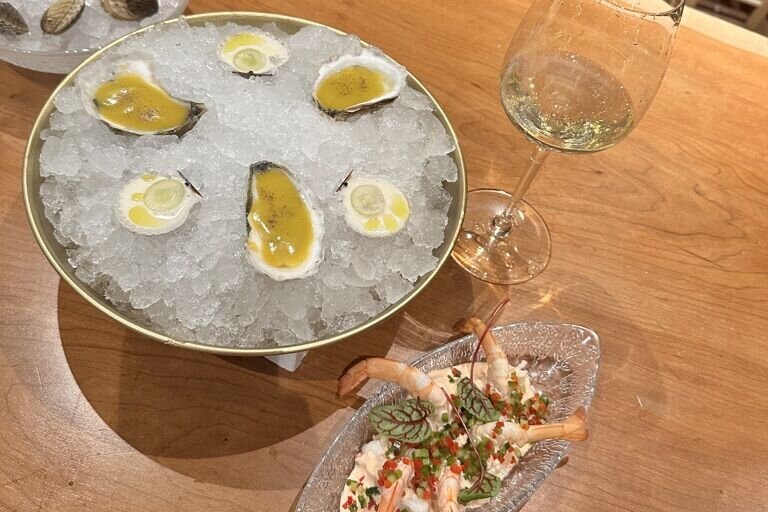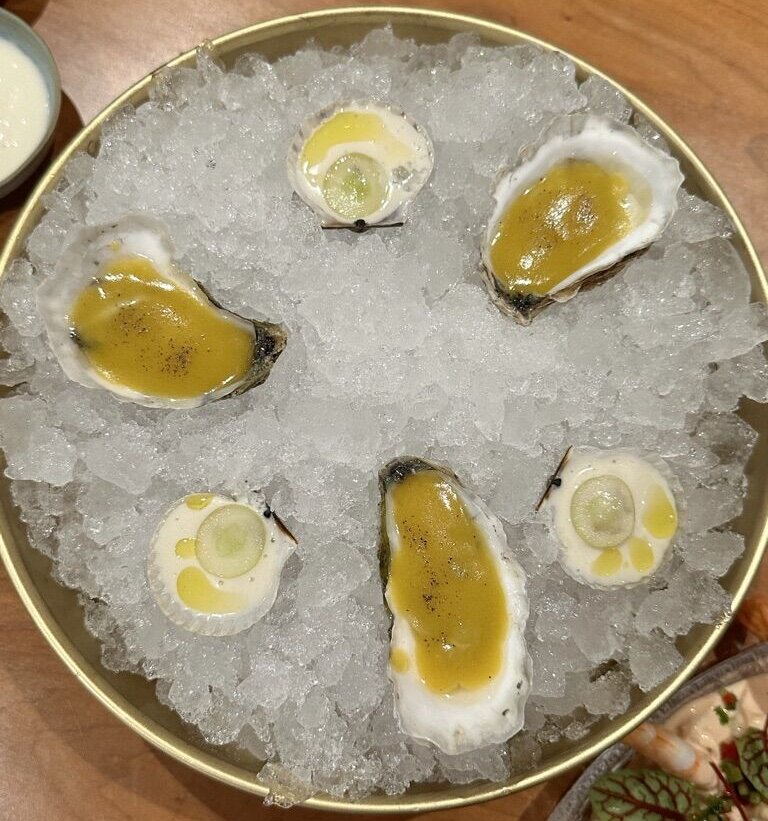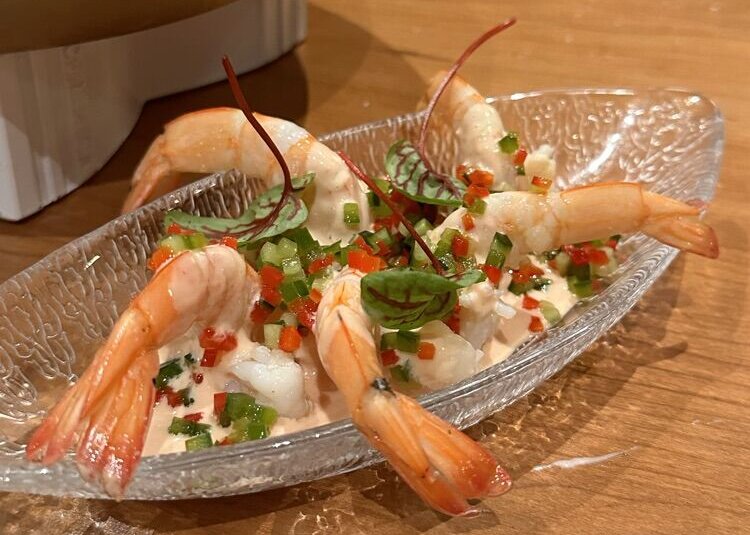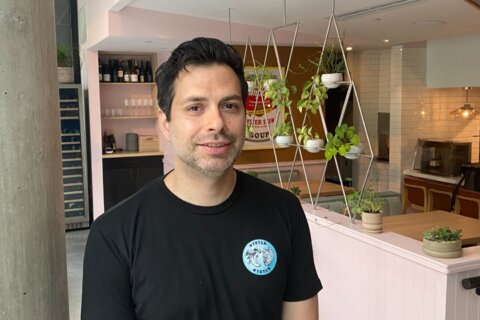Casa Teresa, the new Spanish restaurant at the center of The Square food hall in D.C., is inspired by love. Specifically, Chef Rubén García’s love for the women in his family that created the cuisine he grew up with.
“What we’re serving here is what I’ve been eating all my life. … My aunts, my grandmother and my mother, what they cook for me,” García told WTOP. “I grew up with all the matriarchs in my family surrounding me in the kitchen.”
García has a long history in the D.C. restaurant scene, working with celebrity chef José Andrés to run multiple restaurant concepts. To open Casa Teresa, he left his creative director position at minibar by José Andrés, a Michelin-starred and extremely exclusive D.C. restaurant that he helped create.
“I’ve been working for many, many years, working under the wing of great chefs… I wouldn’t be able to do what I’m doing here without them,” García acknowledged.
Now, he is ready to combine his technical background with the original cooking lessons from the people that inspired him to become a chef: his family.
“The best way to do my own thing was coming back to my roots, kind of a way to start over,” he said. “It’s a really honest cooking that we are doing here.”
Celebrating love and the ‘power’ of sharing a table
This Valentine’s Day, García is celebrating romantic love with a seven-course meal inspired by his Catalonian roots, including a seafood starter that takes a twist on traditional recipes.

García said he believes “a sign of love is sharing,” and that the act of sharing a table “is so powerful.” During the holidays, he reminisces about the foods he was introduced to at large family celebrations where everyone brought a dish and tried “to show off.”
One of the special foods that stuck with him since the first time he tasted it at 12 years old was oysters.
“And I was like, ‘Where have you been all my life?’” García recalled of when his aunt fed him the briny shellfish.
For Valentine’s, diners are served plump East Coast oysters with a traditional escabeche sauce, made with cooked down vinegar, zesty vegetables and saffron. Meat or fish are usually cooked down in the sauce, but García instead has blended it into a vibrant topping that, along with a fresh crack of pepper, mingles perfectly with the raw seafood.
“So you have this really briny, sweet texture of the oyster with these tangy and saffron flavor themes,” García described. “One of my favorite combinations.”
And as for the famous properties of oysters, García jokingly said, “some say this an aphrodisiac … Let’s see what happens at the end of the meal.”

Scallops are also featured on the appetizer platter and are another food that García associates with family, specifically “eating like a pile of them” at bars with his father.
“We have an amazing bay scallops grower … like 45 minutes from here, they do a little tiny one,” García said. These local bay scallops also align with Casa Teresa’s focus on “high end products” and collaborating with smaller distributors.
Another sauce with a twist on traditional Spanish cooking accompanies the local bay scallops.
“We’re gonna serve it raw with the oysters and in this case, with an ajo blanco sauce,” he said. “Ajo blanco is a soup, it’s basically the mother of the gazpacho.”
Ajo blanco was created before tomatoes were introduced to the Spanish peninsula, García explained, so the “really, really basic” soup is made with “bread, garlic, almonds, water and olive oil.”
His application of the soup to raw scallops is anything but basic, dotted with flavorful olive oil and a little slice of grape that adds complexity to the tender meat of the scallop.
The last featured shellfish at first glance doesn’t seem Spanish at all, with the original recipe hailing from the Wild West, but García said this recipe has a special place in his family.
“So, there was a dish that my aunt Sofia used to make only one time a year,” he explained. “And that was for New Year’s Eve. And it was shrimp cocktail.”
García said she made the dish every year because it was delicious and “she thought it was fancy,” but now the dish represents “a lot of good memories” as it became a staple of holidays spent with family.

His version of the American classic uses a homemade cocktail sauce with some added “secret” ingredients, plus a light pipirrana salad made of diced cucumbers, peppers, tomatoes and a light dressing. The Spanish salad adds lightness to a traditionally creamy appetizer.
The drink pairing for this first course also breaks tradition. Wine director Sarah Vanags chose a Spanish cider, called “Poma Áurea” by Trabanco, that tastes almost like “an effervescent, sparkling wine,” she said.
“It has really high notes of apples, it’s really, really earthy, and has a lot of nice dryness, nice acidity, that is going to go really perfect with seafood. It’s a perfect combination,” Vanags explained. “We thought we’d go in a little bit of a different direction and highlight some of the interesting Spanish drinks that you can get.”
Highlighting women’s contributions to Spanish cuisine
Vanags and García have created a unique wine list for the restaurant overall, with over 25 vermouths featured on their menu (and vermouth flights on the way), plus a focus on women-owned Spanish wineries.
“The wine menu that we have representing most of the woman producers in Spain — it’s a thank you. It’s a recognition … for the work,” García said. “Because I’m ashamed to say I didn’t know there were so many women producers and wine producers in Spain with such an amazing quality of wine until we started this project.”
He was inspired to feature women producers in his restaurant by its namesake — his great-grandmother Teresa Espinosa Moreno.
“So my [great] grandmother Teresa was the first woman in the history of Spain that created and lead a political party in defense of the working woman in Spain,” García explained.
He grew up in a family that really respected the work Teresa had done and the care she displayed for her community and her loved ones, he said.
“We’re really proud of what she did. And it means a lot for me and my family,” García said.
García hopes he can bring that same care for his community at his restaurant and highlight “the real heroes, in the Spanish gastronomy history” in his cooking.
“Spanish cuisine, as we see it, is being created in someone’s house always, not the restaurants, in someone’s house by a woman. … Unfortunately, in times where food wasn’t accessible, they needed to find ways to feed their families,” García said. That ingenuity “is what we’re celebrating here.”
García is taking on a lot at his four-month-old restaurant, including recreating family traditions, honoring his great-grandmother’s activism and shining a light on the women that created Spanish cuisine.
He executes his vision gracefully with the Valentine’s Day menu, upending tradition while highlighting how familial food and delicious memories are the focus of Casa Teresa.
Make a reservation and look at the full 7-course, $150 per person holiday menu here.
Get breaking news and daily headlines delivered to your email inbox by signing up here.
© 2024 WTOP. All Rights Reserved. This website is not intended for users located within the European Economic Area.








